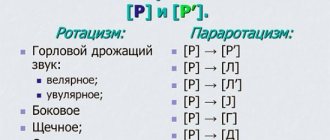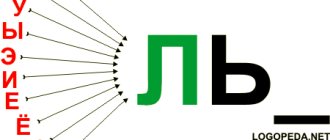Stage of differentiation of the sound “L”
At the stage of differentiation, when the problematic sound has been identified and consolidated, it is taught to be distinguished from similar sounds. What does it mean? See differences in articulation, auditory perception, identify location within a word.
The sound “L” is differentiated in pairs with “P”, “V”, “L” in isolated pronunciation, as well as in syllables, words and sentences.
Speech material on differentiating the sounds “L” and “R”
What do “L” and “R” sound like separately?
Repeat the syllables containing the letters “L” and “R”:
Say the words and help the monkey put the food into different boxes:
Make sentences:
Insert the letters into the words correctly and read the poem:
Differentiation of sounds “L” and “V”
Say “L” first and then “V”. Repeat the syllables with these sounds:
Name the words and group them in three columns:
Listen or read the sentences, try to pronounce the letters “L” and “V” clearly:
Repeat the tongue twisters:
Differentiation of sounds “L” and “L”
Say “L” and “L” and hear their difference in sound. Read the syllables with these sounds:
Name the words in the picture with a hard “L” and a soft “L”:
Proverbs and simple sayings will help you make your pronunciation clear:
What does the algorithm for working with the sound “L” look like?
To learn how to correctly pronounce the letter “L”, you need to consistently go through all the stages of working on its sound pronunciation, without rushing and without jumping from one step to another.
Only after consolidating a skill at one stage can you move on to the next. This will significantly reduce the time and give a stable expected result.
How to make the sound “L” for an adult? The correction process is no different from what is provided in speech therapy for preschool children and schoolchildren. The form may be different - without play elements, if this is a very serious adult.
Now let’s look in detail at what exercises are performed in individual and group classes at each stage of the correction process.
Sound production stage
Several methods are used to make the sound “L”:
Making the sound “L” by imitation
During a speech therapy session, the child is shown in front of a mirror how to position the tongue and lips; how does air pass through such a structure; draw his attention to the slight vibration of his cheeks. The child repeats after the adult. If difficulties arise, game techniques with elements of onomatopoeia come to the rescue, for example, the howl of a police siren “Lllll”.
With this method of production, illustrated material is widely used to create a visual image of the sound. To create a sound and form its kinesthetic image, the baby is asked to feel a warm air stream on his palm while pronouncing the sound.
Making the sound “L” mechanically
This method of sound production involves the use of auxiliary means.
Types of distorted pronunciation of “L”
Speech defect with the letter "L" is called lambdacism. It comes in 4 types:
- Bilabial. The lips are pulled out into a tube and it turns out to be “U” (leaf - uistok, shovel - uapata).
- Nasal. The tongue at the base comes into contact with the soft palate, air enters the nose, creating the sound “NG” (paw - ngapa, bow - nguk).
- Interdental. This position of the tongue gives the sound a lisp.
- Lack of "L". The effect of swallowing sound is created (summer - eto, boat - odka).
When “L” is replaced by other sounds, for example, a child says “V” instead of “L,” then this is paralambdacism.
There are also several replacement options here:
- on “G” (spoon - gozhka, put - pozhka);
- on “B” (fork - vivka, moon - vuna);
- on “Y” (skis - yizhi, lamp - yampa);
- on “D” (sausage - kadbasa, kolobok - kodobok);
- to "L" (little - little, bug - klep).
Differentiation of sounds R-L. Speech material
Distinguishing the sounds R-L by ear and in pronunciation.
Goal: differentiation of R-L sounds. Objectives: 1. To develop in preschoolers correct sound pronunciation, the ability to differentiate R-L sounds in their speech, and to use them correctly. 2. Using a didactic game, diversify the work on consolidating correct sound pronunciation and interest children. Description: The child mixes the sounds R-L very often, not only by ear, but also in pronunciation.
The work I have described on differentiating R-L sounds helps clearer, more conscious pronunciation in general, and is also the basis of writing literacy. These games can be conducted by both a speech therapist and a teacher. This work will be useful to speech therapists, speech therapists, educators, and parents. Contents
First stage Discrimination of R-L sounds in isolation, in syllables and words.
1. Differentiation of L-R sounds in straight syllables with the same vowel sounds.
The “Repeat” game is to clearly pronounce the syllables (first 2, and then 3 syllables). First, an adult acts as the leader, and then you can invite the child to ask syllables, and other children or the teacher repeat. The task of the child leader is to notice mistakes and correct them. la-ra lo-ro lu-ru ly-ry ra-la ro-lo ru-lu ry-ly la-ra-la lo-ro-lo lu-ru-lu ly-ry-ly ra-la-ra ro -lo-ro ru-lu-ru ry-ly-ry 2. Differentiation of R-L sounds in straight syllables with different vowel sounds. The game “Repeat” is also played on these syllables la-ro lu-ry ly-ra le-ro ru-la ry-lo ra-ly lo-ra-ly lu-ry-la ly-ra-lu le-ro- la ry-lu-ro ro-ly-ru re-lu-ro ra-lu-ry ru-ly-re 3. Differentiation of sounds S-SH in words. Game “Repeat” First, the child is asked to repeat after an adult pairs of similar words that differ only in one sound: rama-lama, lov-drov, spoon-horns, lie-rye, game-needle, varnish-crayfish, rose-vine, hand- Luka, pir-pil, flea-brooch, dump-welding.
You can also use the same words to play the game “Change the Word” - after listening to the first word, you need to mentally replace the sound L in it with R or vice versa.
Game “Memories” - take the pictures that the children named when automating each of the sounds, mix them up and lay out 6 pieces in front of the child. While laying out, the child names each picture. After this, the child remembers all 6 pictures and closes his eyes. The teacher removes the 1st picture, and the child, opening his eyes, must name which picture the teacher took away. First, we take pictures where the words contain only 1 sound. For example, rays-streams-lamp-hand-kennel-shark. Then words with both sounds are taken, such as capercaillie-magazine-marmalade-jumping-fisherman-mirror. Second stage Distinguishing R-L sounds in sentences and coherent speech.
1. Differentiation of R-L sounds in independently composed sentences. Game "Come up with a proposal." This game is played on the material of the same pictures that were discussed earlier. The child is given a picture and asked to come up with a sentence using this word. If you are working with a group of children, you can arrange a competition to see who can come up with the most suggestions. For each sentence made, a chip is given, then the result is calculated. Whoever has more chips wins. 2. Differentiation of R-L sounds in rhymes. The “Repeat” game is to repeat rhymes after the teacher, first slowly and then quickly. Nyura's top is beautiful, but small. Mila is beautiful, blue eyes. The artist drew a llama and put the picture in a frame. Grandfather's name is Luka, his hand hurts. Holding a needle in your hands is not a game. Our Lusha has two pears in her hands. Mosquitoes are small, but evil for the time being. The soap is gray, but the wash is white. Among the white doves there is one gray sparrow. The lumberjacks put their axes on the tables. The clever mole climbed onto the raft. Deftly, I take a saw and use the saw to cut wood. 3. Differentiation of R-L sounds in poetic texts. A fisherman sat on the lawn, Patiently digging for worms, A starling saw the fisherman And said: “A real father! Looks for food even better than me. It’s immediately obvious that it’s a big family!” A snail wants to get into the garden, but the gate prevents it. I'm glad to open the gate, let the snail crawl into the garden. I held the gate for a whole hour - A snail crawls quietly. An old dog in the middle of the yard was guarding a sack of goods, The thieves did not take the sack of goods, The thieves stole the watchman. What have you done, wind? What have you made in the sky? From curly clouds I made fish, cows, elephants. The wind, apparently, did not hear, the wind lost its patience, got angry, ran, and mixed up the clouds. Where are the paintings? Where is the river? There are just clouds in the sky.
We recommend watching:
Didactic game for children 5 - 7 years old Speech therapy leisure in the preparatory group Winter tongue twisters and poems for automating and differentiating sounds Didactic game for preschoolers 4-7 years old
Similar articles:
Tongue twisters for practicing the sounds of the Russian language
Automation "L"
Once the sound has been delivered, it needs to be introduced into your everyday speech.
Therefore, at the automation stage, it is consolidated first in isolated sounds, then in syllables and words, then in phrases and sentences.
How? With the help of game exercises, repetition of words, learning poems, tongue twisters, tongue twisters, riddles.
Card file of tasks for automation “L”
Teach your little airplane to say the letter “L” correctly by repeating the syllables:
And now - automation of the “L” sound in words: name the objects and think about where the “L” sound is hidden, at the beginning of the word, in the middle, or maybe at the end?
Here are more words with “L” for sound automation - practice:
Repeat phrases with the sound “L” and try to make sentences from them:
Let's play! This is a game track, name the words and move from top to bottom to our “L”:
Preparatory stage
The child is explained how to pronounce the letter “L” and shown how it should sound. To develop phonemic awareness, words are named and asked to be identified by ear.
Then breathing exercises are performed to form a targeted air stream.
For example, playing table football with a foam ball or the “Hippopotamus” exercise, as in the picture.
At this stage, due attention is paid to articulation warm-up.



